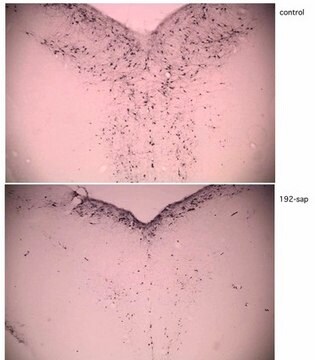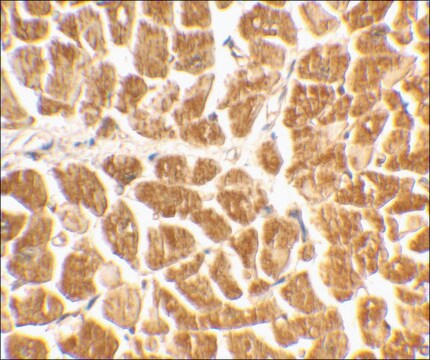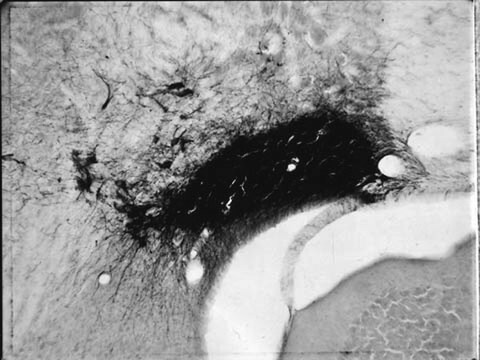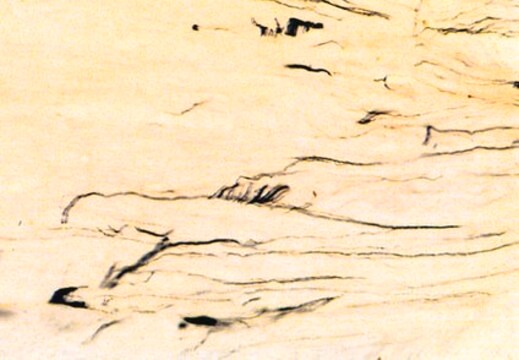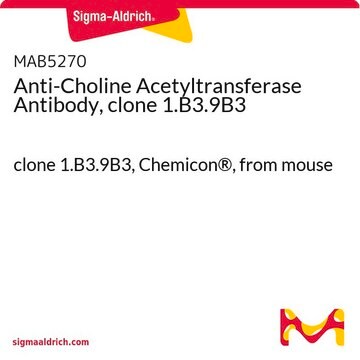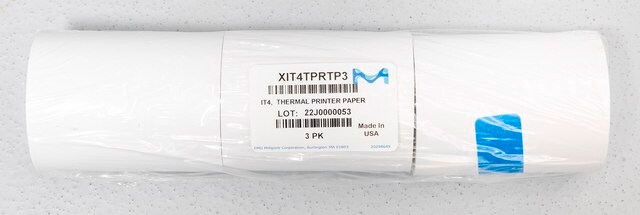MAB394
Anti-Dopamine β Hydroxylase-SAP Antibody, clone 4F10.2
clone 4F10.2, Chemicon®, from mouse
Iniciar sesiónpara Ver la Fijación de precios por contrato y de la organización
About This Item
Código UNSPSC:
12352203
eCl@ss:
32160702
NACRES:
NA.41
conjugado:
saporin
application:
immunolesioning
clon:
4F10.2, monoclonal
reactividad de especies:
rat
citations:
5
técnicas:
immunolesioning: suitable
Productos recomendados
origen biológico
mouse
Nivel de calidad
conjugado
saporin
tipo de anticuerpo
primary antibodies
clon
4F10.2, monoclonal
reactividad de especies
rat
envase
antibody small pack of 25 μg
fabricante / nombre comercial
Chemicon®
técnicas
immunolesioning: suitable
isotipo
IgG1
Nº de acceso NCBI
Nº de acceso UniProt
Condiciones de envío
wet ice
modificación del objetivo postraduccional
unmodified
Información sobre el gen
rat ... Dbh(25699)
Categorías relacionadas
Especificidad
Dopamine b-HydroxylaseDBH is a single gene product that exists as a cytosolic enzyme, as a membrane protein and is secreted into the circulation (Lewis & Asnani, 1992). Because of its residence time as a plasma membrane-bound protein, it is able to be used as a targeting agent for neurons. The target neurons include postganglionic sympathetic neurons and all noradrenergic and adrenergic neurons of the central nervous system. As such anti-DBH-SAP can be used for the production of acute peripheral autonomic failure in a model for the human disease. It can also be used for the analysis of the behavioral effects of noradrenergic or adrenergic ablation. When injected intraventricularly, noradrenergic neurons of the locus coeruleus are eliminated (Wiley & Lappi, 1994). The antibody and immunotoxin undergo retrograde transport.
Aplicación
Anti-Dopamine β Hydroxylase-SAP Antibody, clone 4F10.2 detects level of Dopamine β Hydroxylase & has been published & validated for use in 0.
Otras notas
Concentration: Please refer to the Certificate of Analysis for the lot-specific concentration.
Información legal
CHEMICON is a registered trademark of Merck KGaA, Darmstadt, Germany
¿No encuentra el producto adecuado?
Pruebe nuestro Herramienta de selección de productos.
Certificados de análisis (COA)
Busque Certificados de análisis (COA) introduciendo el número de lote del producto. Los números de lote se encuentran en la etiqueta del producto después de las palabras «Lot» o «Batch»
¿Ya tiene este producto?
Encuentre la documentación para los productos que ha comprado recientemente en la Biblioteca de documentos.
Yuefeng Lu et al.
Anatomical record (Hoboken, N.J. : 2007), 295(7), 1192-1201 (2012-06-08)
Locus coeruleus (LC) consists of a densely packed nuclear core and a surrounding plexus of dendritic zone, which is further divided into several subregions. Whereas many limbic-related structures topographically target specific subregions of the LC, the precise projections from two
C C Wrenn et al.
Brain research, 740(1-2), 175-184 (1996-11-18)
The ability to create lesions of discrete neuronal populations is an important strategy for clarifying the function of these populations. The power of this approach is critically dependent upon the selectivity of the experimental lesioning technique. Anti-neuronal immunotoxins offer an
Soluble and membrane-bound forms of dopamine beta-hydroxylase are encoded by the same mRNA.
Lewis, E J and Asnani, L P
The Journal of Biological Chemistry, 267, 494-500 (1992)
M J Picklo et al.
The Journal of pharmacology and experimental therapeutics, 275(2), 1003-1010 (1995-11-01)
Anti-dopamine beta-hydroxylase immunotoxin (DHIT) is an antibody-targeted noradrenergic lesioning tool comprised of a monoclonal antibody against the noradrenergic enzyme, dopamine beta-hydroxylase, conjugated to saporin, a ribosome-inactivating protein. Noradrenergic-neuron specificity and completeness and functionality of sympathectomy were assessed. Adult, male Sprague-Dawley
Carlos Blanco-Centurion et al.
The Journal of neuroscience : the official journal of the Society for Neuroscience, 27(51), 14041-14048 (2007-12-21)
The hypocretin (HCRT) neurons are located only in the perifornical area of the lateral hypothalamus and heavily innervate the cholinergic neurons in the basal forebrain (BF), histamine neurons in the tuberomammillary nucleus (TMN), and the noradrenergic locus ceruleus (LC) neurons
Nuestro equipo de científicos tiene experiencia en todas las áreas de investigación: Ciencias de la vida, Ciencia de los materiales, Síntesis química, Cromatografía, Analítica y muchas otras.
Póngase en contacto con el Servicio técnico